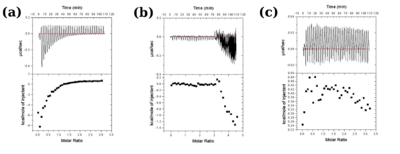Journal:Acta Cryst D:S2059798319004169
From Proteopedia
(Difference between revisions)

| Line 19: | Line 19: | ||
Active site and catalytic base | Active site and catalytic base | ||
| - | Examination of <scene name='81/817979/Cv/11'>conservation of residues in the protein showed that active site colocalises with the zinc binding site</scene>. The colour coding represents conservation of sequence at residue positions, blue representing the least conserved and magenta representing the highly conserved positions. The active site pocket in the centre of the protein colocalises with the bound zinc ion (yellow sphere) and shows highest number of conserved residues. In order to determine the most important residues for catalysis, site directed mutagenesis and activity studies were carried out on the mutants. Based on location in active site, conservation across species and complete loss of activity upon mutation, Lys86 was proposed to be the catalytic base. | + | Examination of <scene name='81/817979/Cv/11'>conservation of residues in the protein showed that active site colocalises with the zinc binding site</scene>. {Template:ColorKey_ConSurf}} The colour coding represents conservation of sequence at residue positions, blue representing the least conserved and magenta representing the highly conserved positions. The active site pocket in the centre of the protein colocalises with the bound zinc ion (yellow sphere) and shows highest number of conserved residues. In order to determine the most important residues for catalysis, site directed mutagenesis and activity studies were carried out on the mutants. Based on location in active site, conservation across species and complete loss of activity upon mutation, Lys86 was proposed to be the catalytic base. |
Concerted movement of residues | Concerted movement of residues | ||
Revision as of 14:10, 11 June 2019
| |||||||||||
This page complements a publication in scientific journals and is one of the Proteopedia's Interactive 3D Complement pages. For aditional details please see I3DC.

